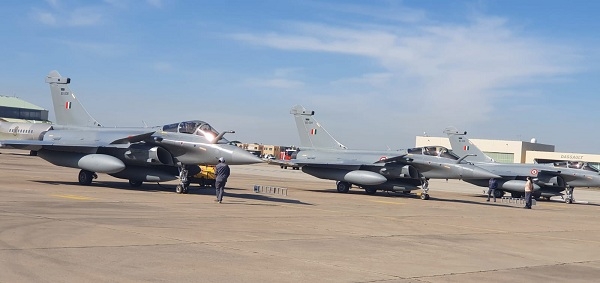Fourth batch of three more Rafale jets land in Gujarat; total reaches 14
01 Apr 2021 11:12:24
New Delhi, April 1: Adding more power to the air arm of the Indian Armed Forces, the 4th batch of three IAF Rafale arrived at Jamnagar base in Gujarat after flying non-stop from the Istres Air Base in France, informed the Indian Air Force.

"The 4th batch of three IAF #Rafales landed on Indian soil after a direct ferry from #IstresAirBase France," the IAF tweeted.
The IAF also thanked the UAE Air Force for refuelling the Rafale fighter jets mid-air, describing it as yet another milestone in the strong relationship between the two Air Forces. "Rafales were refueled in-flight by UAE Air Force tankers. This marks yet another milestone in the strong relationship between the two Air Forces. Thank You UAE AF."
The Indian Embassy in France shared an image of the Rafale fighter jet and the pilots on the mission and tweeted, "Another batch of Rafale take to the skies on non-stop flight to India with mid-air refuelling by UAE. Indian Air power grows further."
Also Read: 3 Rafale fighter jets to land in India today; UAE to provide mid-air refuelling
On Tuesday, Emmanuel Lenain, Ambassador of France to India, had said that five extra Rafale jets will be ferried to India by the end of April. These would be other than the three Rafales which arrived on Wednesday.
Rafale joined the IAF last year in July-August and were soon operationalised. It should be noted, it also has been deployed for patrolling along the China front in eastern Ladakh and other fronts during the height of the China confrontation.
Also Read: 10 new Rafale to join Air Force fleet next month!
In September 2016, India had signed a deal with France for the acquisition of 36 Rafale multi-role fighter jets in a fly-away condition along with 13 India Specific Enhancements (ISE) under a €7.87 billion (Rs. 60,000 crore) Inter-Governmental Agreement (IGA).
India-specific enhancements on the Rafales include a helmet-mounted sight, radar warning receivers, flight data recorders with storage for 10 hours of data, infrared search and track systems, jammers, cold engine start capability to operate from high-altitude bases and towed decoys to ward off incoming missiles.
The twin-engine jet is capable of carrying out a variety of missions – ground and sea attack, air defence and air superiority, reconnaissance and nuclear strike deterrence. It can carry almost 10 tonnes of weapons.
